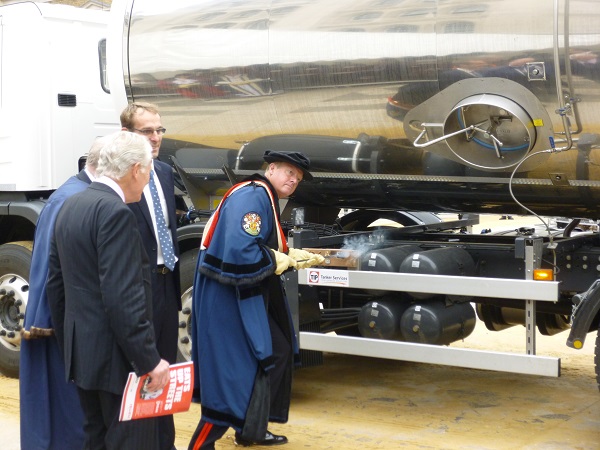Readers from overseas (and some from the UK) may well wonder what on earth this article is about. Cart marking in London? What’s that got to do with the moving industry? Well, nothing – and everything. Steve Jordan explains.

It depends how you look at it. Either way cart marking is today merely ceremonial however, as the UK does do ceremony particularly well, in my opinion, it’s an essential part of understanding the past and, in consequence, the present.
For centuries the City of London has licensed vehicles (originally carts) to ply their trade in the City. Each vehicle would carry a numbered brass plate and be marked with the City arms. In 1838 this power was vested in the keeper of Guildhall who marked the vehicles of the Freemen of the Fellowship of Carmen to park and operate on the London streets. Each year the Freemen would bring their vehicles to Guildhall to receive a brand from a red-hot iron onto a wooden plate fixed to the vehicle denoting the letter of the year.
In 1965 the concession was deemed to contravene parking regulations in the City and was discontinued. In 1982, however, a band of enthusiasts, including Michael Gerson, breathed life into the tradition which has continued ever since. Today, vehicle owners bring along their much loved treasures, old and new, to receive the brand from the Sheriff of London and the Master Carman.
The weather looked dull for the 2015 proceedings, however the heavy mist was all the English climate could muster as the assembled dignitaries - including Sheriff, Fiona Adler; Master Carman, Lieutenant Colonel Paul Holder; and Master Glover (she who supplies the heat resistant glove to prevent injury to the brander), Ann Esslemont - and the rest of us mere mortals, took our places. The procession started.
 A 1935 London taxi led the way and was appropriately branded with the annual letter ‘X’ before being sent on its way. The rest followed: a courier motorcycle, a forklift truck, trailers, tractors, a milk cart (the fastest one in the west made famous by Benny Hill), military vehicles, busses, removal pantechnicons, dustcarts - some petrol, some diesel, many horse drawn, one steam powered and one 7.5 tonner powered by electricity. As every vehicle came through the commentators – Liverymen Chris Salaman and Mike Stone and Freeman Roger Wrapson – described them in intricate detail demonstrating their encyclopaedic knowledge of all things that move and the people who move them. It was a strangely emotional experience and a reminder that London cares about history – and history has cared for London.
A 1935 London taxi led the way and was appropriately branded with the annual letter ‘X’ before being sent on its way. The rest followed: a courier motorcycle, a forklift truck, trailers, tractors, a milk cart (the fastest one in the west made famous by Benny Hill), military vehicles, busses, removal pantechnicons, dustcarts - some petrol, some diesel, many horse drawn, one steam powered and one 7.5 tonner powered by electricity. As every vehicle came through the commentators – Liverymen Chris Salaman and Mike Stone and Freeman Roger Wrapson – described them in intricate detail demonstrating their encyclopaedic knowledge of all things that move and the people who move them. It was a strangely emotional experience and a reminder that London cares about history – and history has cared for London.
Dinner was served in 15th Century Guildhall - its name is derived from ‘gilt’, meaning ‘payment’ and was the place where people came to pay their taxes – the scene of many famous trials and under the watchful eyes of Sir Winston Churchill, the Duke of Wellington and Admiral Lord Nelson as if to ensure diners remember to use the correct cutlery.
The food was exquisite. The toasts were respectful, grace was said with levity, and Paul Holder’s speech was comprehensive, brief, funny and included a diversion from protocol to offer special congratulations and thanks to the chef who had pulled off the seemingly impossible trick of serving perfect medium-rare rib eye steak to 650 people simultaneously.
Some will say that this type of ceremony is pointless and outdated. I say it’s an essential link with the past that helps to remind us all of the regard with which our industry was held by our forefathers. There are many today who would benefit from remembering the honourable roots that have led us this far and the responsibility they carry to preserve some semblance of it for the future.
Photos: The Annual Cart Marking in London Click for the next Editor's Pick